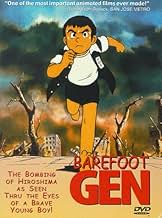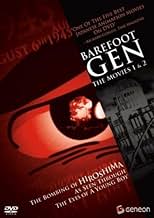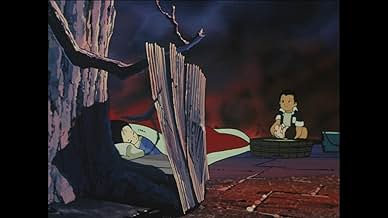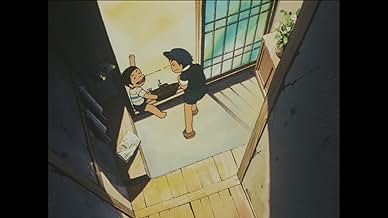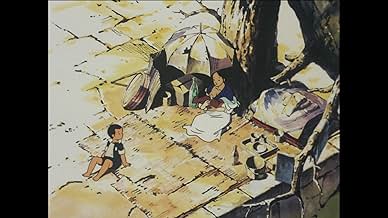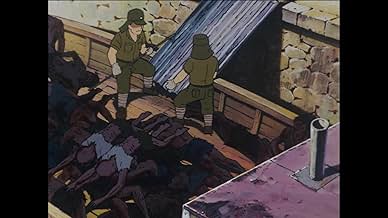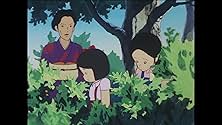AVALIAÇÃO DA IMDb
8,0/10
9,9 mil
SUA AVALIAÇÃO
Relata a história do efeito da bomba atômica na vida de uma criança e na vida do povo japonês.Relata a história do efeito da bomba atômica na vida de uma criança e na vida do povo japonês.Relata a história do efeito da bomba atômica na vida de uma criança e na vida do povo japonês.
- Direção
- Roteirista
- Artistas
- Prêmios
- 1 vitória no total
Issei Miyazaki
- Gen
- (narração)
Catherine Battistone
- Gen (1995)
- (English version)
- (narração)
Yoshie Shimamura
- Kimie
- (narração)
Iona Morris
- Kimie (1995)
- (English version)
- (narração)
Masaki Kôda
- Shinji
- (narração)
- …
Brianne Brozey
- Shinji (1995)
- (English version)
- (narração)
- (as Brianne Siddal)
Barbara Goodson
- Ryuta (1995)
- (English version)
- (narração)
Takao Inoue
- Daikichi
- (narração)
Kirk Thornton
- Daikichi (1995)
- (English version)
- (narração)
- (as Kurk Thornton)
Seiko Nakano
- Eiko
- (narração)
Wendee Lee
- Eiko (1995)
- (English version)
- (narração)
Takeshi Aono
- Eizo
- (narração)
Michael McConnohie
- Eizo
- (English version)
- (narração)
- (as Amike McConnohie)
- …
Katsuji Mori
- Seiji
- (narração)
Taeko Nakanishi
- Hana
- (narração)
Junji Nishimura
- Pak
- (narração)
Ardwight Chamberlain
- Pak
- (English version)
- (narração)
- …
Avaliações em destaque
I've basically pasted this from wikipedia, but since the autobiographical element to this story wasn't mentioned I thought I should post it. There is an interesting article with the artist here http://www.tcj.com/256/i_nakazawa.html (中沢 啓治, Keiji Nakazawa, born 1939) is a Japanese manga artist and writer.
He was born in Hiroshima, and was in the city when it was destroyed by an atomic bomb in 1945. All of his family members who had not been evacuated died in the bombing except for his mother, and an infant sister who died several weeks after the bombing.
In 1961, Nakazawa moved to Tokyo to become a full-time cartoonist, and produced short pieces for manga anthologies such as Shonen Gaho, Shonen King, and Bokura.
In 1966, following the death of his mother, Nakazawa returned to his memories of the destruction of Hiroshima and began to express them in his stories. Kuroi Ame ni Utarete (Struck by Black Rain), the first of a series of five books, was a fictional story of Hiroshima survivors involved in the postwar black market. In 1972, Nakazawa chose to portray his own experience directly in the story "Ore wa Mita" ("I Saw It"), published in Monthly Shonen Jump (In 1982, the story was translated into English and published as a one-shot comic book by Educomics as "I Saw It").
Immediately after finishing "I Saw It", Nakazawa began his major work, Hadashi no Gen (Barefoot Gen). This series, which eventually filled ten volumes (six volumes in English translation), was based on the same events as "I Saw It" but fictionalized, with the young Gen as a stand-in for the author. Barefoot Gen depicted the bombing and its aftermath in graphic detail, but also turned a critical eye on the militarization of Japanese society in the World War II years, and on the sometimes abusive dynamics of the traditional family. Barefoot Gen was made into an animated film, released in 1983. It was followed three years later by a sequel.
He was born in Hiroshima, and was in the city when it was destroyed by an atomic bomb in 1945. All of his family members who had not been evacuated died in the bombing except for his mother, and an infant sister who died several weeks after the bombing.
In 1961, Nakazawa moved to Tokyo to become a full-time cartoonist, and produced short pieces for manga anthologies such as Shonen Gaho, Shonen King, and Bokura.
In 1966, following the death of his mother, Nakazawa returned to his memories of the destruction of Hiroshima and began to express them in his stories. Kuroi Ame ni Utarete (Struck by Black Rain), the first of a series of five books, was a fictional story of Hiroshima survivors involved in the postwar black market. In 1972, Nakazawa chose to portray his own experience directly in the story "Ore wa Mita" ("I Saw It"), published in Monthly Shonen Jump (In 1982, the story was translated into English and published as a one-shot comic book by Educomics as "I Saw It").
Immediately after finishing "I Saw It", Nakazawa began his major work, Hadashi no Gen (Barefoot Gen). This series, which eventually filled ten volumes (six volumes in English translation), was based on the same events as "I Saw It" but fictionalized, with the young Gen as a stand-in for the author. Barefoot Gen depicted the bombing and its aftermath in graphic detail, but also turned a critical eye on the militarization of Japanese society in the World War II years, and on the sometimes abusive dynamics of the traditional family. Barefoot Gen was made into an animated film, released in 1983. It was followed three years later by a sequel.
Barefoot Gen is the autobiographical story of manga artist, Keiji Nakazawa and his experience during the times of the Hiroshima bombings in 1942. What ensues is something so unbelievable, so gritty, so real, it will change your life forever.
The film is adapted as an anime from Keiji's short manga series depicting all that he experienced just at the age of six when the bombings hit. His story truly is one of the most amazing things you will ever hear. Nothing else in film has ever captured the effects of the bombings in such a real and emotional way. It shows the viewers what really did happen and what we were never told. It shows us how real the bombings really were as we follow Gen through his struggle for survival during Japan's darkest hours.
If you haven't seen this film, you are missing out. While the film does not hold back on the gritty details, and what happens to the people of Japan throughout the whole of the film is very horrifying, you cannot miss this film due to these aspects. It's these things that make it so real and it would be a tragedy to ignore this film. It opened my eyes to what really went down in Hiroshima and I almost felt personally affected. During my whole time watching this film, I kept finding myself in disbelief that something like this actually occurred in our history, and recently at that. I mean, a whole society was rebuilt on the effects of the bombings and once again shows us how very, very wrong war is. One of the best films I have ever seen.
9.5/10 Hamish Kearvell A.K.A Screaming Japan Productions - www.myspace.com/screamingjapanproductions
The film is adapted as an anime from Keiji's short manga series depicting all that he experienced just at the age of six when the bombings hit. His story truly is one of the most amazing things you will ever hear. Nothing else in film has ever captured the effects of the bombings in such a real and emotional way. It shows the viewers what really did happen and what we were never told. It shows us how real the bombings really were as we follow Gen through his struggle for survival during Japan's darkest hours.
If you haven't seen this film, you are missing out. While the film does not hold back on the gritty details, and what happens to the people of Japan throughout the whole of the film is very horrifying, you cannot miss this film due to these aspects. It's these things that make it so real and it would be a tragedy to ignore this film. It opened my eyes to what really went down in Hiroshima and I almost felt personally affected. During my whole time watching this film, I kept finding myself in disbelief that something like this actually occurred in our history, and recently at that. I mean, a whole society was rebuilt on the effects of the bombings and once again shows us how very, very wrong war is. One of the best films I have ever seen.
9.5/10 Hamish Kearvell A.K.A Screaming Japan Productions - www.myspace.com/screamingjapanproductions
Many compare Grave of the Fireflies with Hadashi no Gen/Barefoot Gen. While there are certainly similarities, such as the timeline taking place near the end of the war with Japan, the main difference is that Grave deals mostly with the inhumanity of the Japanese people toward their own kind, while Gen revolves less on this than it does the overall horrors of the after-effects of the nuclear blast at Hiroshima. The hooks used in the respective animes are thus, quite different. While Grave makes one shake their head and wonder about how humanity is sacrificed on the altar of survival and self-centeredness, Gen rests heavily on the outright horror that the dropping of Fat Man unleashed on an entire population.
Animation styles are vastly different also. Grave was made in conjunction with Miyazaki of studio Ghibli (Totoro), and thus was very polished in appearance. Gen, on the other hand, has a mostly "old-fashioned" anime feeling, reminiscent of the "Golden Age of Anime" in the 80's, using devices that are very manga; overblown representations of runny noses and buckets of tears from characters, for example.
In the end, Hadashi no Gen should be on the shelf of every anime collector. When someone says to them that anime is "just for kids", pop this in the VCR and show them just how in-depth, heart wrenching and thought provoking simple pen and ink cells can become. You will have to watch it twice; it's hard to get all the nuances while wiping tears from your eyes.
Animation styles are vastly different also. Grave was made in conjunction with Miyazaki of studio Ghibli (Totoro), and thus was very polished in appearance. Gen, on the other hand, has a mostly "old-fashioned" anime feeling, reminiscent of the "Golden Age of Anime" in the 80's, using devices that are very manga; overblown representations of runny noses and buckets of tears from characters, for example.
In the end, Hadashi no Gen should be on the shelf of every anime collector. When someone says to them that anime is "just for kids", pop this in the VCR and show them just how in-depth, heart wrenching and thought provoking simple pen and ink cells can become. You will have to watch it twice; it's hard to get all the nuances while wiping tears from your eyes.
9cpto
The story is excellent, the animation effective, but the lack of in-between frames is intrusive in spots. For the full story, read the graphic novels. They provide an even more effective tale.
As with Nosaka's "Grave of the Fireflies," Gen deals with a Japanese youth in the waning days of WW II. The first 30 minutes shows him to be typical for his stage of life, swinging between a self-centered boy and an adult. He is suddenly thrust into the position of head of the family after the Hiroshima bomb kills his father, brother, and sister, and destroys the city. The remainder of the movie deals with his transformation into an adult, with adult sensibilities and adult responsibilities.
Gen is clearly a Japanese story - the author, Nakazawa, lived through the event as a child. But the story could have taken place in Dresden or London just as easily. Although the atomic bomb is the event the movie revolves around, the story is really about the people - the children - and the effect the event has on their lives.
It's too bad that so much of the books had to be sacrificed to the time limits of a film. The novels delve much more deeply into the cruel society that Japan was in the 1940s. For example, much more was made of the neighbor's Korean background in the book; in the movie, you wouldn't realize the ethnicity if you didn't think about the name.
As a conventional film, Gen would probably be too honest to find real appeal in the U.S. Worse, the animation format will probably dissuade those who would otherwise see and appreciate it. Like most Japanese anime, this is not a "cartoon." It is a serious film in an unconventional - for the U.S. - medium.
The DVD transfer is excellent and belongs in your collection. This is a movie that continues to educate and enlighten with each viewing.
As with Nosaka's "Grave of the Fireflies," Gen deals with a Japanese youth in the waning days of WW II. The first 30 minutes shows him to be typical for his stage of life, swinging between a self-centered boy and an adult. He is suddenly thrust into the position of head of the family after the Hiroshima bomb kills his father, brother, and sister, and destroys the city. The remainder of the movie deals with his transformation into an adult, with adult sensibilities and adult responsibilities.
Gen is clearly a Japanese story - the author, Nakazawa, lived through the event as a child. But the story could have taken place in Dresden or London just as easily. Although the atomic bomb is the event the movie revolves around, the story is really about the people - the children - and the effect the event has on their lives.
It's too bad that so much of the books had to be sacrificed to the time limits of a film. The novels delve much more deeply into the cruel society that Japan was in the 1940s. For example, much more was made of the neighbor's Korean background in the book; in the movie, you wouldn't realize the ethnicity if you didn't think about the name.
As a conventional film, Gen would probably be too honest to find real appeal in the U.S. Worse, the animation format will probably dissuade those who would otherwise see and appreciate it. Like most Japanese anime, this is not a "cartoon." It is a serious film in an unconventional - for the U.S. - medium.
The DVD transfer is excellent and belongs in your collection. This is a movie that continues to educate and enlighten with each viewing.
This is the sort of movie that I would rate up there with Schindler's list. Its haunting and powerful. This is also the sort of movie that I feel that every history teacher who teaches American History should show their students at some point in time. While some of the scenes do get a bit annoying, it still brings home the horrors of what occurred at the end of World War II. The other thing is the point of view, which was not "anti American" and doesn't try and place blame, which makes this all the more powerful.
Você sabia?
- CuriosidadesThe author of the "Barefoot Gen" manga, Keiji Nakazawa, said that 70% of the story is based on true events from his experience of the atomic bombing of Hiroshima.
- Erros de gravaçãoWhen Gen and Shinji take a big bite from a sweet potato from each end, they are then told by Eiko to give the sweet potato to their mother. Once the sweet potato is given to her, it is whole again.
- Citações
Daikichi Nakaoka: This war can't be right. But it's only the cowards like me who dare say it. If there were only a few more like us. You know, sometimes it takes more courage not to fight than to fight, to not want to kill when all around you are calling out for blood. That's real courage in my book. If you boys remember nothing else I teach you, I hope you'll remember that.
- Cenas durante ou pós-créditosThe closing credits run horizontally from the left side. Above the credits is footage of a paper boat lantern built sailing past multiple lanterns. After the boat has slowly vanished, the lanterns slowly turn into stars.
- Versões alternativasThere's a slightly different version of the movie on the website Rumble. Only one change has been applied to it which is the cut to the scene where Kimie (Gen's mom) finds a dead woman on the forest.
- ConexõesFeatured in Gen Pés Descalços 2 (1986)
Principais escolhas
Faça login para avaliar e ver a lista de recomendações personalizadas
- How long is Barefoot Gen?Fornecido pela Alexa
Detalhes
- Data de lançamento
- País de origem
- Idioma
- Também conhecido como
- Gen de los pies descalzos
- Empresas de produção
- Consulte mais créditos da empresa na IMDbPro
Contribua para esta página
Sugerir uma alteração ou adicionar conteúdo ausente

